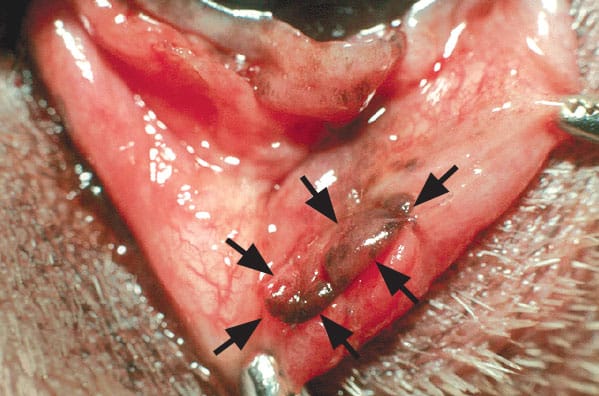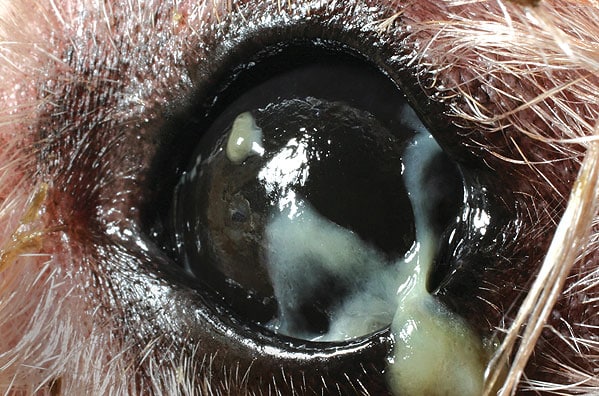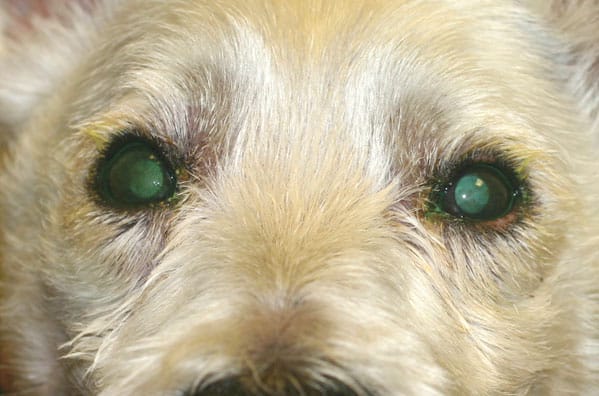
A small proportion of dogs which suffer from dry eye do not respond to medical management. In these patients the problem is unfortunately so severe that the eye remains painful and badly diseased despite the use of cyclosporine and artificial tears. In order to alleviate discomfort and prevent vision-threatening corneal scarring (or even ulceration and rupture of the eyeball), the procedure known as a parotid duct transposition is often used in such severe cases.
What is a parotid duct transposition?
The parotid duct is a tube that carries saliva from the parotid salivary gland into the mouth. In a parotid duct transposition, this duct is surgically relocated from the mouth into the pocket below the eye – this results in the eye being kept moist with saliva instead of the missing tears.
Can saliva replace tears adequately?
Saliva does not have exactly the same composition as tears. However, it is usually well tolerated and can prevent the severe effects of chronic dry eye in the majority of dogs. A small minority of patients show signs of irritation from the saliva. In rare cases, surgery will not resolve the signs of discomfort and in these circumstances the operation may have to be reversed.
What does a parotid duct transposition involve?
The surgery is carried out under a general anaesthetic and the side of the face is clipped. During the anaesthetic, the patient’s heart rate, blood pressure and blood oxygen concentration are monitored, and a fluid infusion is given intravenously to maintain good blood circulation.
The surgeon must wear magnifying glasses to allow visualisation of the parotid duct and to prevent damage to the delicate tissues surrounding the duct. An incision is made into the skin on the side of the face and after identifying and mobilising of the duct, its opening (the papilla) is freed from the normal position in the mouth, and moved into the pocket below the eye where it is stitched into place with self-dissolving sutures. The incision on the side of the face is closed using small sutures.

The opening of the parotid duct (arrowed) has been stitched into the pocket below the eye using very fine sutures
Post-operatively, a small amount of wound swelling can occur both at the site of the facial incision and on the lower eyelid. The surgery is not especially painful – the operated eye is usually open and quite comfortable immediately following recovery from anaesthesia.
What aftercare will be required?
Post-operatively, the patient needs to wear an Elizabethan collar to prevent damage to the wound by rubbing or scratching. Gentle cleaning of the operated eye with wet cotton wool twice daily is recommended. An antibiotic ointment is generally applied to the eye for approximately ten days post-operatively. The facial wound should not require any attention, and suture removal (if required) is carried out after seven to 10 days. A short course of antibiotics and mild painkillers is usually dispensed. The patient is fed little and often to stimulate saliva production and it is necessary to check that saliva flows into the eye at the time of each feeding.
Are there possible unwanted side-effects of a parotid duct transposition?
In some patients, copious amounts of saliva will be produced at feeding time or during excitement (e.g. on exercise, car journeys, visits to the vet etc.). In this case, saliva may flow over the eyelids onto the side of the face. If salivary overflow is marked, staining of the facial hair and inflammation of the skin can occur. These problems are usually easy to manage with regular clipping of the facial hair and the application of a barrier cream such as Sudocrem or Vaseline.
In some patients, calcium salt crystals from the saliva are deposited on the corneal surface and the eyelid edges. These deposits can sometimes cause slight irritation but can generally be removed by the eye specialist under a local anaesthetic. Rarely, corneal ulceration can occur in association with the mineral deposits and surgery of the affected area may be necessary. Ocular lubricants and occasionally a change in diet may be used to try to reduce calcium salt deposition.
Will I still need to apply eye drops after the parotid duct transposition?
Generally, medication will be stopped, following a short course of antibiotic eye ointment immediately after surgery. Some patients will benefit from the occasional use of a lubricant eye ointment. A parotid duct transposition allows the owners of affected patients to resume a relatively normal life-style without the constant application of eye treatments.
Can my own veterinary surgeon carry out a parotid duct transposition?
Parotid duct transposition is a procedure that requires a skilled and experienced micro-surgeon using equipment for magnification and illumination, as well as fine surgical instruments that will not damage delicate tissues. For this reason most general practitioners will recommend referral to an ophthalmic specialist for this procedure to be carried out.

The eye of a West Highland White Terrier which has become blind due to deposition of dense pigment in the cornea as a result of dry eye The eye of a West Highland White Terrier which has become blind due to deposition of dense pigment in the cornea as a result of dry eye
Do I have to return to the eye specialist for the aftercare?
A few post-operative check-ups with the eye specialist are generally recommended to ensure an optimal outcome of the surgical procedure. Thereafter, most patients do not require frequent veterinary attention and a return to the eye specialist is only necessary in selected cases.

The same patient after parotid duct transposition in both eyes. The corneal pigment has dispersed and the pupils can now be seen inside the eyes – the eyes have regained vision The same patient after parotid duct transposition in both eyes. The corneal pigment has dispersed and the pupils can now be seen inside the eyes – the eyes have regained vision.
If you have any queries or concerns, please do not hesitate to contact us.
Arranging a referral for your pet
If you would like to refer your pet to see one of our Specialists please visit our Arranging a Referral page.